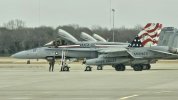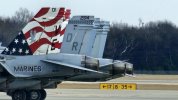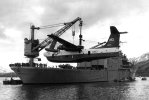The Air Tractor is a bad ass little plane but doing the MOD is a bitch, 50 lbs of shit in a 5 lb bag.Looks a little more butch in the production configuration, anyway. View attachment 38896
But yeah, it is an odd choice for the T/M/S designation. Apparently AFSOC did decide to continue the A-1 series - the last USAF Spad was the A-1J - despite them not being in any way related and only bearing a superficial resemblance. I'm all for heritage but the designations are supposed to be an accurate description. Could've called it the OA-30A Skyraider II or something.
-
Please take a moment and update your account profile. If you have an updated account profile with basic information on why you are on Air Warriors it will help other people respond to your posts. How do you update your profile you ask?
Go here:
Edit Account Details and Profile
You are using an out of date browser. It may not display this or other websites correctly.
You should upgrade or use an alternative browser.
You should upgrade or use an alternative browser.
The Great, Constantly Changing Picture Gallery, Troisième partie: la vengeance!
- Thread starter SynixMan
- Start date
Valid question, but there's also something to be said that in the next, presumably higher intensity, broader bounds conflict, there will be different sorts of theaters, with different levels of permissive environment, etc... and there will also be a need, frankly, to throw anything we can at the problem, across a range of platforms. Currently reading Freedom's Forge about the business and supply chain side of ramping up WWII industry - really a great read for a number of reasons, but certainly sobering if you compare and contrast the American economy - particularly the dependence on a truly global supply chain, not just with things like chips but raw material inputs. With that piece of reading, and I understand this is a touch of a departure from the thread topic, I really am thinking more that the next conflict is going to be a function of 'what can we field,' and not 'what is the perfect platform.'
The concern is this mission was crafter around "The Last War". I'll be curious if the buy goes to the full 75+ airframes.
That's certainly valid, but there's also something to be said for caution against over-focusing on the next war instead.
I was recently reading a pretty good history of WWII sub warfare, across all theaters, and it struck me how often during the inter-war years most of the major navies designed, trained, and built based on how "everybody knew" the Next Big War was going to be fought, which turned out to be mostly nothing like what actually happened.
Doctrine for the USN and IJN, for example, assumed their war against each other kicking off with attacks on US, British, and Dutch far western Pacific possessions (Singapore, PI, Malaya, etc), followed by both fleets massing and pushing out against each other, culminating a huge Fleet-on-Fleet battle (Yamamoto's plan for Pearl was based entirely on screwing up that plan for the US). Anyway, American, Japanese, and British subs were designed around that Big Battle concept, either as fast Fleet subs which would be scouts/skirmishers for the main body, or as big, long-range "cruiser subs" operating outside the sealanes. As it happened, since they weren't going to be doing what they planned, the Fleet subs found their niche as commerce raiders to blockade Japan, while the cruiser subs were too big and slow to fight with the main body and couldn't dive fast enough to evade ASW aircraft; almost all of them were scrapped, sunk, or sidelined before the war was over.
The Germans, on the other hand, planned their U-Boat designs and doctrine for the last war, assuming they'd need to do what they did during the Great War - break a British/French blockade, and attack convoys from North America - just do it better. They invaded Norway and Denmark and northern France at least partly to avoid getting bottled up in the North Sea like the High Seas Fleet was during WWI. Though they failed in the end, it was mainly due to being overwhelmed by the endless stream of new merchant hulls and improvements in the escorts, not because of doctrine, training, or equipment.
What was the title of the book?I was recently reading a pretty good history of WWII sub warfare, across all theaters, and it struck me how often during the inter-war years most of the major navies designed, trained, and built based on how "everybody knew" the Next Big War was going to be fought, which turned out to be mostly nothing like what actually happened.
I think the Combat Air Tractor could have a role in Big War III. Indeed, it fits in nicely with the new USMC concept. It might also be a nice escort to a helicopter CSAR scenario just as the A-1 was the preferred CSAR support asset in Vietnam.
What was the title of the book?
War Beneath the Sea: Submarine Conflict During World War II
I found it interesting because it's a survey of sub warfare across all the major combatants and theaters, not just focusing on the U-Boats or the Pacific campaign as books tend to do, and looked at it from a "how they intended to fight" vs "how they actually wound up fighting" perspective. I hadn't read much about what the sub forces did during the inter-war years, and this gets into it pretty comprehensively. It's pretty fascinating, especially in current context.[//finex threadjack]
Oh…I thought you were reading “How Not To Lose World War II - For Dummies.”War Beneath the Sea: Submarine Conflict During World War II
I found it interesting because it's a survey of sub warfare across all the major combatants and theaters, not just focusing on the U-Boats or the Pacific campaign as books tend to do, and looked at it from a "how they intended to fight" vs "how they actually wound up fighting" perspective. I hadn't read much about what the sub forces did during the inter-war years, and this gets into it pretty comprehensively. It's pretty fascinating, especially in current context.
[//finex threadjack]
It's interesting to see a crop duster/tow plane modded up as a warplane. But it's cool.The Air Tractor is a bad ass little plane but doing the MOD is a bitch, 50 lbs of shit in a 5 lb bag.
Thanks!War Beneath the Sea: Submarine Conflict During World War II
I found it interesting because it's a survey of sub warfare across all the major combatants and theaters, not just focusing on the U-Boats or the Pacific campaign as books tend to do, and looked at it from a "how they intended to fight" vs "how they actually wound up fighting" perspective. I hadn't read much about what the sub forces did during the inter-war years, and this gets into it pretty comprehensively. It's pretty fascinating, especially in current context.
[//finex threadjack]
GroundPounder
Well-Known Member
Was this 115's fini flight?
GroundPounder
Well-Known Member
This is just a guess, but I think the aircraft has been transfered to another Bueafort Squadron and not yet repainted. I took that picture 11 Jan 24 at KAGS.Was this 115's fini flight?
I looked it up on that day, and VMFA 115 had already been disestablished..
Sad. I flew a couple of their jets a number of times out in Fallon. Nice A++'s......only of those I ever got a chance to fly, though they do round out my career, having flown every single variant/sub variant and major production lot of the F/E/A-18 (other than EMD/test articles). They had 3x full color Super Hornet like DDIs/MPCD. Litening G4 pod. Big motors, and all the other stuff. Only weird thing was if you brought up the SA page and the HSI at the same time (this being before the two were combined), the displays would often fully shut down and you'd have to cycle the power on them to get them back. Kind of not awesome in a high workload moment.





